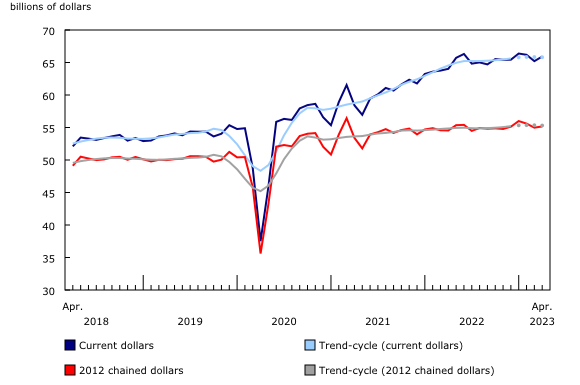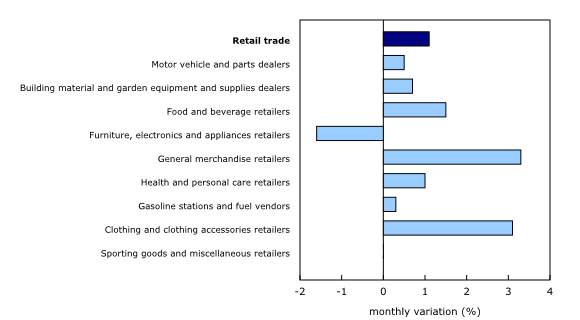Retail trade, April 2023
Released: 2023-06-21
$65.9 billion
April 2023
1.1% 
(monthly change)
$0.9 billion
April 2023
-1.1% 
(monthly change)
$0.3 billion
April 2023
-0.2% 
(monthly change)
$1.8 billion
April 2023
4.4% 
(monthly change)
$1.4 billion
April 2023
2.5% 
(monthly change)
$14.8 billion
April 2023
0.9% 
(monthly change)
$24.8 billion
April 2023
1.3% 
(monthly change)
$2.2 billion
April 2023
0.8% 
(monthly change)
$2.1 billion
April 2023
0.8% 
(monthly change)
$8.4 billion
April 2023
0.9% 
(monthly change)
$9.0 billion
April 2023
0.5% 
(monthly change)
$0.1 billion
April 2023
2.8% 
(monthly change)
$0.1 billion
April 2023
3.8% 
(monthly change)
$0.1 billion
April 2023
3.5% 
(monthly change)
Retail sales increased 1.1% to $65.9 billion in April. Sales increased in eight of nine subsectors and were led by increases at general merchandise retailers (+3.3%) and food and beverage retailers (+1.5%).
Core retail sales—which exclude gasoline stations and fuel vendors and motor vehicle and parts dealers—increased 1.5% in April.
In volume terms, retail sales increased 0.3% in April.
Core retail sales increase on gains at general merchandise retailers and food and beverage retailers
Core retail sales increased 1.5% in April, posting its fifth consecutive monthly increase. The gain was led by higher sales at general merchandise retailers (+3.3%). Higher sales were also recorded at food and beverage retailers (+1.5%), with all store types in this subsector posting increases.
The largest decrease to core retail sales came from furniture, home furnishings, electronics and appliance retailers (-1.6%). Sales were down in all three store types, with lower sales at electronics and appliance retailers (-1.3%) leading the decline.
Sales at motor vehicle and parts dealers and gasoline stations and fuel vendors rise
After their decline in March, sales at motor vehicle and parts dealers increased 0.5% in April. The increase was led by higher sales at used car dealers (+3.7%), followed by automotive parts, accessories and tire retailers (+3.5%). The largest decline in this subsector were sales of other motor vehicle dealers (-1.2%), which recorded their second consecutive decrease.
Also contributing to the increase in retail sales in April were higher sales at gasoline stations and fuel vendors (+0.3%). In volume terms, sales at gasoline stations and fuel vendors decreased 1.5%.
Sales up in eight provinces
Retail sales increased in eight provinces in April. The largest provincial increase was observed in Ontario (+1.3%), led by higher sales at motor vehicle and parts dealers. In the Toronto census metropolitan area (CMA) , retail sales were up 1.4%.
In Quebec, retail sales increased 0.9% in April. In the Montréal CMA, retail sales were down 0.3%.
The largest provincial decrease in April was observed in Newfoundland and Labrador (-1.1%). The decrease was driven by lower sales at motor vehicle and parts dealers.
Retail e-commerce sales in Canada
On a seasonally adjusted basis, retail e-commerce sales were down 6.1% to $3.6 billion in April, accounting for 5.5% of total retail trade compared with 5.9% in March.
Advance retail indicator
Statistics Canada is providing an advance estimate of retail sales, which suggests that sales increased 0.5% in May. Owing to its early nature, this figure will be revised. This unofficial estimate was calculated based on responses received from 40.6% of companies surveyed. The average final response rate for the survey over the previous 12 months was 89.2%.
Note to readers
As of the January 2023 reference period, Monthly Retail Trade Survey (MRTS) figures are based on the North American Industry Classification System (NAICS) 2022 classification structure. This new classification structure has, in effect, broadened the scope of the MRTS results.
All data in this release are seasonally adjusted and expressed in current dollars, unless otherwise noted.
Seasonally adjusted data are data that have been modified to eliminate the effect of seasonal and calendar influences to allow for more meaningful comparisons of economic conditions from period to period. For more information on seasonal adjustment, see Seasonally adjusted data – Frequently asked questions.
The percentage change for the advance estimate of retail sales is calculated using seasonally adjusted data and is expressed in current dollars.
This early indicator is a special unofficial estimate being provided in the context of the COVID-19 pandemic to offer Canadians timely information on the retail sector. The data sources and methodology used are the same as those outlined on the Monthly Retail Trade Survey information page.
Trend-cycle estimates are included in selected charts as a complement to the seasonally adjusted series. These data represent a smoothed version of the seasonally adjusted time series and provide information on longer-term movements, including changes in direction underlying the series. For information on trend-cycle data, see Trend-cycle estimates – Frequently asked questions.
Both seasonally adjusted data and trend-cycle estimates are subject to revision as additional observations become available. These revisions could be extensive and could even lead to a reversal of movement, especially for the reference months near the end of the series or during periods of economic disruption.
Seasonally adjusted estimates for cannabis store retailers are presented in unadjusted form, as no seasonal pattern has been established by official statistics yet. Establishing such a pattern requires several months of observed data. In the interim, the seasonally adjusted estimates for cannabis store retailers will be identical to the unadjusted figures.
Some common e-commerce transactions, such as travel and accommodation bookings, ticket purchases and financial transactions, are not included in Canadian retail sales figures.
Total retail sales expressed in volume terms are calculated by deflating current-dollar values using consumer price indexes.
Find more statistics on retail trade.
Next release
Data on retail trade for May will be released on July 21.
Contact information
For more information, or to enquire about the concepts, methods or data quality of this release, contact us (toll-free 1-800-263-1136; 514-283-8300; infostats@statcan.gc.ca) or Media Relations (statcan.mediahotline-ligneinfomedias.statcan@statcan.gc.ca).
- Date modified:


